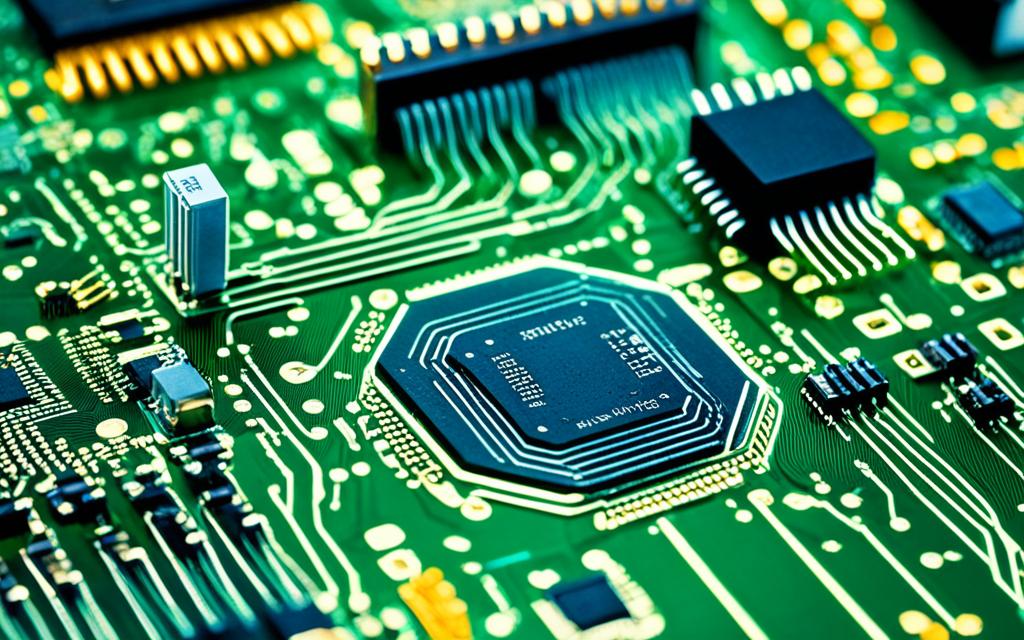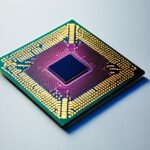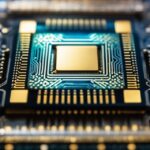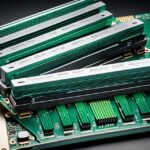Table of Contents
The Central Processing Unit (CPU) acts as the brain of every computing device. It carries out the critical job of executing instructions from machine language programs. Knowing how a CPU works is key for anyone interested in computer science, affecting software development and hardware design.
The main part of this process is the fetch-decode-execute cycle. This is a set of steps showing how the CPU handles data and turns it into tasks. It greatly boosts computing efficiency. Moreover, modern methods like pipelining, introduced by IBM in 1956, have changed CPU architecture. They allow faster operations, which are common in today’s processors. For a deeper look into these ideas, visit this resource1.
Key Takeaways
- The CPU executes instructions through a systematic cycle, comprising fetch, decode, and execute phases.
- Pipelining enables significant performance enhancements by overlapping instruction execution.
- Modern CPUs utilise sophisticated techniques like superscalar execution to improve speed and efficiency.
- Understanding the foundational machine language and binary code enhances insight into CPU function.
- The evolution of CPU technology from vacuum tubes to transistors has allowed for remarkable advancements in processing speed.
The Role of the Central Processing Unit
The Central Processing Unit, or CPU, acts as the brain of a computer system. It is made up of parts that handle instructions and data. Knowing how these CPU parts work together shows us how important it is for complex tasks. It also tells us how it has changed over time.
What Constitutes a CPU?
The CPU has two main parts: the Arithmetic Logic Unit (ALU) and the Control Unit (CU). The ALU performs arithmetic and logic operations like adding and comparing. Meanwhile, the CU makes sure everything runs smoothly by sending instructions to parts2. There are also registers. They temporarily hold data and instructions needed right away2.
Technology has greatly improved CPU design. Nowadays, CPUs use integrated circuits (ICs) and have more than one core3. This means they can do multiple things at the same time, making them better at multitasking3.
Importance of the CPU in Computing
The CPU is crucial in computing. It processes millions of instructions every second. This allows it to handle many tasks at once4. A CPU’s performance can make a big difference in how well a computer works. This includes everything from simple math to playing complex games. Cache memory is key here. It stores data that is used often, making the computer work faster4.
As technology advances, CPUs are getting better. They use new methods like pipeline and speculative execution. These improvements help CPUs work faster and do more. Understanding these changes helps us appreciate the CPU more. It shows how essential it is, both in the past and today.
Machine Language: The Foundation of Instructions
Machine language is the rock on which all computer calculations stand. It is made of binary code, a language computers understand directly. Knowing machine language is key to seeing how processors work fast and well.
Understanding Machine Language
Since the first electronic computers in the 1940s, machine language has been key5. It runs straight on the CPU, making things work quicker than with complex programming languages5. Every command is a mix of bits, or 1s and 0s. This is the computer’s language6. But, programming this way is hard and easy to mess up5.
Binary Code: The Language of Computers
Binary code is crucial for machine language and the only code computers truly understand6. Languages like Swift or C++ turn into machine language before a computer runs them6. It turns complex tasks into simple binary forms for processing6. Also, machine code changes with different computers, like Intel x86 versus PowerPC6.
| Aspect | Machine Language | Higher-Level Languages |
|---|---|---|
| Execution Speed | Executed directly by CPU | Requires compilation |
| Complexity | Complex and error-prone | More abstract and user-friendly |
| Portability | Platform-dependent | Generally portable across systems |
| Control | Detailed hardware control | Less control over hardware specifics |
| Use Cases | Embedded systems, OS development | Application development, web apps |
Learning machine language well can give someone a deep insight into computers. It connects the way we program and how computers really work.
“The evolution of machine language is crucial for technology and computing progress.”5
Fetch-Decode-Execute Cycle Explained
The fetch-decode-execute cycle is key to how a CPU works. It has three parts: fetch, decode, and execute. Each one is vital for a computer to run smoothly7. Knowing these steps helps us understand how computers work fast and efficiently.
What Happens in the Fetch Phase?
In the fetch phase, the CPU gets an instruction from RAM. The Program Counter aids in this, tracking where each instruction is8. This is the first step and crucial for what comes next. Today’s processors can do this very quickly, thanks to new technology. It makes sure instructions are fetched without delay7.
Decoding Instructions: The Control Unit’s Task
Next, in the decode phase, the Control Unit turns the instruction into signals. This readies the CPU for the action ahead8. The success of this step depends on the CPU’s design. For example, superscalar processors decode faster because they handle many instructions at once. A mistake in decoding can stop the CPU from working8.
Execution Phase: Where Actions Occur
Then comes the execution phase. This is when calculations and data handling happen, mostly using the Arithmetic Logic Unit (ALU)7. A faster clock rate means more cycles and better performance8. This cycle keeps going, letting the CPU manage tasks well. It shows just how powerful today’s computers are7.
When a CPU Executes Instructions as it Converts Data into Actions
In the complex CPU world, the act of carrying out instructions changes raw data into meaningful actions. Each step requires loading the needed info into fast CPU registers. This prepares for quick access to key details for arithmetic.
How Data is Loaded into Registers
Data moves into CPU registers after instructions are fetched. The CPU quickly puts this info into its registers, speeding up processing. A CPU’s speed can depend on its clock speed, usually around 2 GHz. With organised registers, CPUs handle many tasks at once. This highlights how crucial data execution and retrieval are.
Arithmetic Operations in the CPU
Once data is in the registers, arithmetic calculations begin. The ALU is key here, doing tasks from simple addition to complex functions. For multiplication, the CPU gets variables from the registers, does the operation, and sends the result back into memory. This process boosts computing, showing how CPUs use one core to act like many9.
The way CPUs work majorly impacts system performance. Better processors, with bigger caches, make data access faster. Level 1 caches are crucial for quick arithmetic. The interaction between data in registers and arithmetic work shows modern computing power10.
| Operation | Example | Registers Involved |
|---|---|---|
| Addition | A + B | R1, R2, R3 |
| Subtraction | A – B | R1, R2, R3 |
| Multiplication | A * B | R1, R2, R3 |
| Division | A / B | R1, R2, R3 |
In summary, CPUs must execute instructions well for best computing. This ensures everything runs smoothly.
Registers and Their Importance in Instruction Execution
Registers are key to a CPU’s work. They offer quick access to data and commands, making operations smoother. Different types of registers have different tasks. For example, general purpose registers hold temporary data for arithmetic tasks. On the other hand, special purpose registers, like the Program Counter (PC), are vital for the order of operations.
Types of Registers: General and Special Purpose
In the AARCH32 setting, there are 16 integer registers. Three of these have special roles11. Moving to AARCH64, the number grows to 30, matching modern computing needs. The instruction register keeps the binary code of the current task. This setup helps the CPU handle many tasks smoothly by separating general and special uses.
The Function of the Program Counter
The Program Counter is essential. It’s a 16-bit register that knows where the next task is12. After finishing one task, it moves to the next, ensuring order. Each step forward marks progress.
When the system resets, the PC goes back to zero. This shows it’s ready to start over12.
Overall, the success of operations relies on these registers. General and special types work together. They improve how data is handled and speed up processing. This showcases the CPU’s crucial role in computing13.
FAQ
What is the primary function of a CPU?
The main job of a Central Processing Unit (CPU) is to act as the computer’s brain. It runs instructions from programs, making all the computing tasks happen. This affects how well the computer works.
What are the key components of the CPU?
A CPU has important parts like the Arithmetic Logic Unit (ALI), Control Unit (CU), and registers. They work together to handle and carry out instructions.
How does machine language relate to CPU operations?
Machine language is made up of basic binary instructions that the CPU can understand. It turns more complex programming languages into code that can be executed.
Can you explain the fetch-decode-execute cycle?
The fetch-decode-execute cycle is a critical process for a CPU. First, it picks up an instruction from memory (fetch). Then it figures out what the instruction means (decode). Finally, it does the action, like making calculations (execute).
What role do registers play in CPU operations?
Registers are vital for the CPU’s fast working because they store the temporary data. This quick access data is necessary for doing maths and running instructions, improving speed.
What distinguishes general purpose registers from special purpose registers?
General purpose registers handle temporary data and do maths jobs. But special purpose registers, like the Program Counter, are for specific tasks. They keep track of the order in which instructions happen.
How does the Program Counter function within the CPU?
The Program Counter is a special register. It keeps the address of the next instruction that will run, helping the CPU work in an orderly manner.
Source Links
- https://www.vaia.com/en-us/explanations/computer-science/computer-organisation-and-architecture/pipelining/ – ‘Instruction & Operations’, ‘Pipeline Stages’
- https://homepage.cs.uri.edu/faculty/wolfe/book/Readings/Reading04.htm – How The Computer Works: The CPU and Memory
- https://en.wikipedia.org/wiki/Central_processing_unit – Central processing unit
- https://softwareg.com.au/blogs/computer-hardware/when-a-cpu-executes-instructions-as-it-converts – When A CPU Executes Instructions As It Converts
- https://tokyotechlab.com/blogs/ngon-ngu-may – What is Machine Language? Applications of Machine Language
- https://www.javatpoint.com/what-is-machine-language – What is Machine Language – javatpoint
- https://unacademy.com/content/nta-ugc/study-material/computer-science/fetch-execute-cycle/ – Fetch Execute Cycle
- https://www.vaia.com/en-us/explanations/computer-science/computer-organisation-and-architecture/fetch-decode-execute-cycle/ – Fetch Decode Execute Cycle: Steps & Definition
- https://www.redhat.com/sysadmin/cpu-components-functionality – The central processing unit (CPU): Its components and functionality
- https://www.brainscape.com/flashcards/chapter-3-4-10393505/packs/18585915 – Chapter 3, 4 Flashcards by Jaqueline Pereira Santos
- https://bob.cs.sonoma.edu/IntroCompOrg-RPi/sec-cpureg.html – Introduction to Computer Organization: ARM Assembly Language Using the Raspberry Pi
- https://www.geeksforgeeks.org/instruction-register/ – Instruction Register – GeeksforGeeks
- https://wou.edu/las/cs/csclasses/cs160/VTCS0/MachineArchitecture/Lessons/CPU/Lesson.html – Untitled Document








